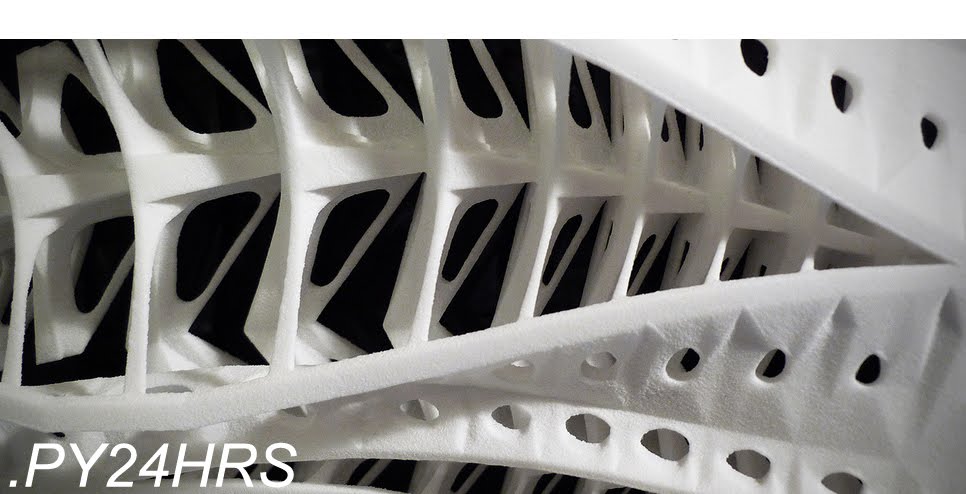 |
| Leaf Srf |
DayTwo_Leaf Paneling
The Leaf Surface investigates the python scripting possibilities to accommodate a fairly simple paneling principle. Panels are bent in the diagonal axis according to their distance parameters to the point of attraction. A surface, populated with these customized elements can create and interesting structure with smooth transitions between closed and open /bent/ quads.CODE:
import rhinoscriptsyntax as rs
#obtain surface from rhino
srf = rs.GetObject("Pick the reference surface",8)
attractor = rs.GetObject("Please pick a Point of attraction",1)
attractorCoord = rs.PointCoordinates(attractor)
#surface domain
uDomain = rs.SurfaceDomain(srf, 0)
vDomain = rs.SurfaceDomain(srf, 1)
#print uDomain,vDomain
uLength = uDomain[1] - uDomain[0]
vLength = vDomain[1] - vDomain[0]
subdivU = 20
subdivV = 20
stepU = uLength/subdivU
stepV = vLength/subdivV
#surface sampling
#main list which will contain sub-list/rows
mainList = []
mainListNormals = []
listDistances = []
rs.EnableRedraw(False)
for i in rs.frange(uDomain[0],uDomain[1]+0.01,stepU):
for j in rs.frange(vDomain[0],vDomain[1]+0.01,stepV):
ptCoord = rs.EvaluateSurface(srf,i,j)
Pt = rs.AddPoint(ptCoord)
distance = rs.Distance(attractor,Pt)
rs.DeleteObject(Pt)
listDistances.append(distance)
listDistances.sort()
distMin = listDistances[0]
distMax = listDistances[len(listDistances)-1]
if distMin > distMax:
distMax = listDistances[0]
distMin = listDistances[len(listDistances)-1]
treshold = (distMax-distMin)*0.5
print distMin
print distMax
for i in rs.frange(uDomain[0],uDomain[1]+0.01,stepU):
#sub-list containing pts
subList = []
subListNormals = []
for j in rs.frange(vDomain[0],vDomain[1]+0.01,stepV):
ptCoord = rs.EvaluateSurface(srf,i,j) #3d coordinates Pt
NormalCoord = rs.SurfaceNormal(srf,[i,j])#3d coordinates Pt offset
PtN = rs.AddPoint(NormalCoord)
Pt = rs.AddPoint(ptCoord) #3d point ID
PtN = rs.VectorUnitize(PtN)
distance = rs.Distance(attractor,Pt)
if (distMax-distance)<treshold:
PtNormal = Pt
else:
PtN = rs.VectorScale(PtN,(distMax-distance-treshold)**2/250)
PtNormal = rs.VectorAdd(Pt,PtN)
subList.append(Pt)
subListNormals.append(PtNormal)
mainListNormals.append(subListNormals)
mainList.append(subList)
#-----------------------------------------------------------------------------
#Paneling
filletRad = 0.5
for i in range(0,len(mainList)-1):
for j in range(0,len(mainList[i])-1):
Pt00 = mainList[i][j]
# Pt01 = mainList[i+1][j]
Pt02 = mainList[i+1][j+1]
# Pt03 = mainList[i][j+1]
# Pts = [Pt00,Pt01,Pt02,Pt03,Pt00]
# rs.AddCurve(Pts,1)
# Pt00N = mainListNormals[i][j]
Pt01N = mainListNormals[i+1][j]
# Pt02N = mainListNormals[i+1][j+1]
Pt03N = mainListNormals[i][j+1]
# PtsN = [Pt00N,Pt01N,Pt02N,Pt03N,Pt00N]
Pts001 = [Pt00,Pt01N]
Pts002 = [Pt01N,Pt02]
Pts011 = [Pt02,Pt03N]
Pts012 = [Pt03N,Pt00]
crv01 = rs.AddCurve(Pts001,2)
crv02 = rs.AddCurve(Pts002,2)
crv11 = rs.AddCurve(Pts011,2)
crv12 = rs.AddCurve(Pts012,2)
#add fillets
strFilletCrv00 = rs.AddFilletCurve(crv12,crv01,filletRad)
strFilletCrv10 = rs.AddFilletCurve(crv11,crv02,filletRad)
#evaluate fillets for points
dblFilletCrvDomain00 = rs.CurveDomain(strFilletCrv00)
FilletPt00 = rs.EvaluateCurve(strFilletCrv00,dblFilletCrvDomain00[0])
FilletPt01 = rs.EvaluateCurve(strFilletCrv00,dblFilletCrvDomain00[1])
dblFilletCrvDomain10 = rs.CurveDomain(strFilletCrv10)
FilletPt10 = rs.EvaluateCurve(strFilletCrv10,dblFilletCrvDomain10[0])
FilletPt11 = rs.EvaluateCurve(strFilletCrv10,dblFilletCrvDomain10[1])
#add new lines inbetween the quad corners and the fillet ends
crv01 = rs.AddCurve([Pt03N,FilletPt00],3)
crv02 = rs.AddCurve([Pt01N,FilletPt01],3)
crv11 = rs.AddCurve([Pt03N,FilletPt10],3)
crv12 = rs.AddCurve([Pt01N,FilletPt11],3)
#join the fillets and curves and loft them to a surface
joinedCrv01 = rs.JoinCurves([crv01,strFilletCrv00,crv02],True)
joinedCrv02 = rs.JoinCurves([crv11,strFilletCrv10,crv12],True)
# print joinedCrv01[0]
rs.RebuildCurve(joinedCrv01[0],3,30)
rs.RebuildCurve(joinedCrv02[0],3,30)
rs.AddLoftSrf([joinedCrv01[0],joinedCrv02[0]])
rs.EnableRedraw(True)











